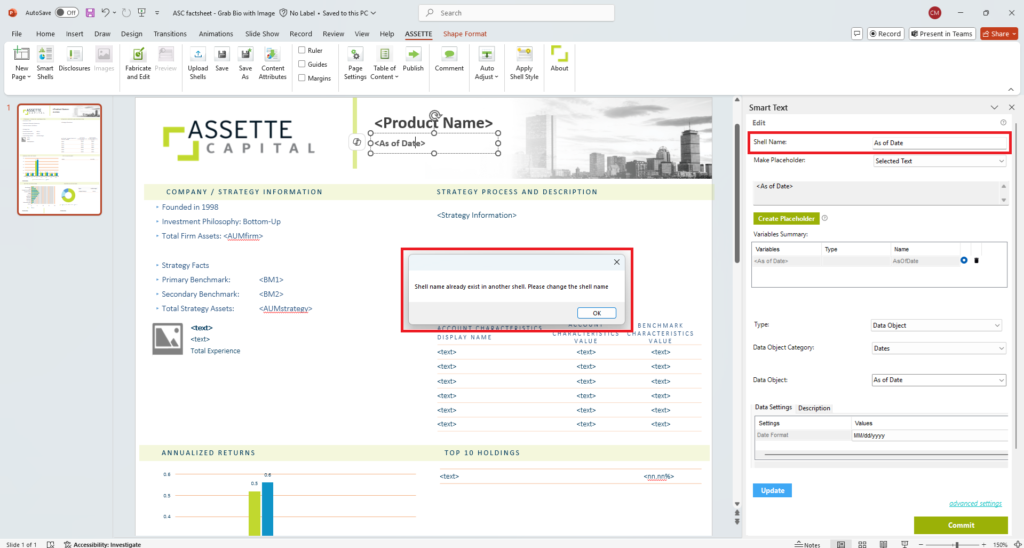What Naming Conventions Should We Use for Smart Shells? #
When it comes to naming a Smart Shell (or, for that matter, any content in Assette) it is best practice to choose a standardized naming convention that is to be used throughout the entire organization that is functional and descriptive. Choosing one of the following common naming conventions. Data Object may only use letters (either upper or lowercase), numbers, hyphens or underscores in the name.
- Camel Case
- First letter of every word is capitalized with no spaces or symbols between words.
- Examples: UserAccount, FedEx, WordPerfect. A variation common in programming is to start with a lower case: iPad, eBay, fileName, userAccount.
- Pascal Case
- Popularized by Pascal programming language, this is a subset of Camel Case where the word starts with uppercase. Thus, UserAccount is in Pascal Case but not userAccount.
- Popularized by Pascal programming language, this is a subset of Camel Case where the word starts with uppercase. Thus, UserAccount is in Pascal Case but not userAccount.
- Snake Case
- Words within phrases or compound words are separated with an underscore.
- Examples: first_name, error_message, account_balance
Can Multiple Smart Shells Have the Same Name? #
Smart Shells within the same Smart Page must have unique names. If a name is re-used, the user will receive a message stating “Shell name already exists in another shell. Please change the shell name.” While all Smart Shell’s within a Smart Page must be unique, Smart Shell names may be re-used on another Smart Page without issue. Please note that Smart Shell names may include spaces, this means that “AsofDate” and “As of Date” would be considered unique names for two Smart Shells occupying the same Smart Page.

Can I Name a Smart Shell “New”, “Old”, or “Test”? #
Yes, you can name the Smart Shell as you see fit, however Assette recommends that it remain descriptive and functional names. Assette also recommends that if users create Smart Shells named “Test”, “New”, etc. that they are renamed or removed as soon as practicable.
How Do Users Distinguish Between Functionally Identical Smart Shells? #
Sometimes it’s impossible to avoid having to create a Smart Shells nearly identical functionality as an existing one. In this case, Assette suggests using adding an extra adjective to the name to help differentiate the two.
This scenario is most frequently seen when a Smart Shell is shown differently for two or more strategies, in this case Assette recommends simply adding the strategy’s abbreviation to the Smart Shell’s name.
Can Users Search for Smart Shells in the Output Center by Name? #
No, users can only search for a specific Smart Shell by name directly in the Smart Shell screen of the Authoring Center. However, users can view the X-Ray feature to view a Smart Page’s Smart Shells from the Smart Page screen.
I Accidentally Deleted a Smart Shell, Can I Restore it? #
Yes, users can email the Assette Client Service Team to restore the deleted the Data Object. Please be sure to include the name of the deleted Smart Shell or other identifying information. Additionally, users are prohibited from deleting any Smart Shell that are used by other content.
How do I Refresh a Smart Shell? #
Smart Shells can be refreshed by clicking on the applicable Smart Shell’s advanced actions and selecting “Refresh Shell” from the menu. This will show all the pages that use the selected shell. The user can select the smart pages across which the updated shell should be applied. The user can choose to apply the Shell Structure, Data Settings and Shell Settings as needed.
